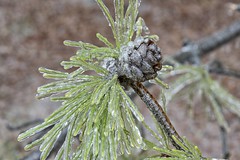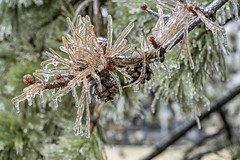Jul 25 2005
Gorilla gorilla

Time—Time is running out for the gorillas and their habitat. To find out more and how you can help preserve these magnificent and closely related primates go to the Gorilla Fund, founded by Dian Fossey.
This photograph was taken at the Congo Gorilla Forest at the Bronx Zoo.
Some interesting facts about the gorilla:
The largest and most robust of the primates, the gorilla is also a gentle, intelligent and sociable animal which lives a peaceful, quiet existence if undisturbed. Its body, covered with coarse black hair, is massive, with a short, broad trunk and wide chest and shoulders. The head is large, with a short muzzle, and the eyes and ears small; old males have high crowns. The muscular arms are longer than the short, thick legs, and the broad hands are equipped with short fingers and thumbs. Males are bigger and heavier than females, and those over 10 years old have silvery-gray hair on their backs — hence the name silverback, given to old males. There are two races: the lowland and the mountain gorilla, also referred to as the western and eastern races, respectively. On the ground, gorillas normally move in a stooped posture, with the knuckles of the hands resting on the ground, but they do stand erect on occasion. Females and juveniles climb trees, but males rarely do so because of their great bulk.
Gorillas live in a close-knit group of a dominant male, 1 or 2 other males, several females and young; some groups may contain only the dominant male, 2 or 3 females and young. The group wanders in a home range of 4 to 15 1/2 sq miles, which is not defended or marked at the boundaries. There may be some conflict with neighboring groups, but encounters are generally avoided by communications such as drumming on the ground from a distance. Old males will threaten rivals by standing erect and beating the chest while roaring and barking and sometimes by tearing up and throwing plants. When the leader of a troop dies, younger males contest for dominance. Gorillas are active in the daytime. The troop rises between 6 A.M. and 8 A.M., feeds for a while on plant material, such as leaves, buds, stalks, berries, bark and ferns, and then has a period of rest and relaxation. Gorillas do not appear to drink but get the water they need from their juicy diet. They feed again in the afternoon and then retire for the night in nests made of twigs and leaves. Young gorillas under 3 years old sleep with their mothers, but all others have their own nests. Breeding appears to take place at any time of year. The female gives birth to a single young after a gestation of more than 9 months. The young is completely dependent and clings to its mother’s fur at first, but it is able to sit up at 3 months and to walk and climb at 5 months. It suckles for 12 to 18 months and remains with its mother for about 3 years.




























